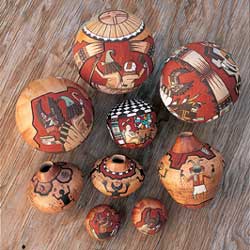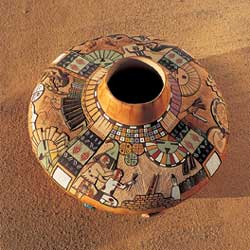Residing atop a Hopi mesa, this potter has become nationally recognized
Lawrence Namoki grew up in the traditional way—no Quarter Pounders at McDonald’s, no Friday nights at the movies—in the insular world of the Hopi people. In his hometown of Walpi, a 300-year-old village on Arizona’s First Mesa, there was nothing for kids to do but adventure in the outdoors, hunting rabbits and hiking the canyons. You could say his up-bringing was akin to the Americana spirit of Mark Twain and Huckleberry Finn.
 But there were also mysterious influences. Namoki’s father, Maxwell, was one of the high priests of Hopi society and a preeminent kachina maker, but young Namoki never got to watch him work since carving was restricted to the inner sanctum of ceremonial kivas in his society. In his early teens, when Namoki was initiated into the Kachina Society, his dad finally put a piece of cottonwood in his hands and told him how to make the sacred icon. “Every human being has the capability to be an artist,” he was instructed. “Maybe someday you will realize it, but it will take time. You’ll have to search for it.”
But there were also mysterious influences. Namoki’s father, Maxwell, was one of the high priests of Hopi society and a preeminent kachina maker, but young Namoki never got to watch him work since carving was restricted to the inner sanctum of ceremonial kivas in his society. In his early teens, when Namoki was initiated into the Kachina Society, his dad finally put a piece of cottonwood in his hands and told him how to make the sacred icon. “Every human being has the capability to be an artist,” he was instructed. “Maybe someday you will realize it, but it will take time. You’ll have to search for it.”
Back then, Namoki was more interested in chasing other Hopi legacies. For four years as he attended school off the rez at Phoenix Indian High School, he was a member of the championship track-and-field team and an acclaimed long-distance runner. In college at Northern Arizona University, he switched to law, thinking he would help his tribe by returning to the reservation as its sole criminal attorney.
His formal education ended at the height of the Vietnam War. Lured by the promise of real adulthood, he enlisted in the Army, where his physical fitness earned him a spot in the Green Berets. He trained as an airborne paratrooper, but before he could be shipped overseas, Saigon fell and the war was over. However, the war had already taken a personal toll on him: Namoki came home addicted to drugs and alcohol. It required the encouragement of his wife and the looming responsibilities of fatherhood to turn him around. Carving miniature kachinas—pieces 2 1/2 inches tall and smaller—brought him back to his roots and offered a way to support his family.
 In 1980, attending his first Santa Fe Indian Market, Namoki wandered down a street and was drawn to a gallery window filled with pottery. “I just stood there, visualizing what kind of design I’d put on those pots,” he remembers. “As soon as I got ahold of clay myself, instantly some spirit entered and took control of my body.” Over the next few years, Namoki taught himself the age-old art form of his native First Mesa. Once he became comfortable with the clay, recognition quickly followed. His public debut as a potter, at the Eight Northern Indian Pueblos Arts and Crafts Fair at San Ildefonso Pueblo in New Mexico in 1985, garnered Best of Show and Governor’s Award ribbons.
In 1980, attending his first Santa Fe Indian Market, Namoki wandered down a street and was drawn to a gallery window filled with pottery. “I just stood there, visualizing what kind of design I’d put on those pots,” he remembers. “As soon as I got ahold of clay myself, instantly some spirit entered and took control of my body.” Over the next few years, Namoki taught himself the age-old art form of his native First Mesa. Once he became comfortable with the clay, recognition quickly followed. His public debut as a potter, at the Eight Northern Indian Pueblos Arts and Crafts Fair at San Ildefonso Pueblo in New Mexico in 1985, garnered Best of Show and Governor’s Award ribbons.
More than a foot in circumference and divided into four sections, his winning piece was inspired by the Hopi ceremonial calendar and depicted the seasonal activities of his people. Namoki’s masterpiece now permanently resides at the Millicent Rogers Museum in Taos, NM.
Early on in his career, the advice of Santa Clara Pueblo potter Nathan Youngblood gave him support and direction. “Nathan told me to develop my pottery, that it was all in me,” Namoki recalls. “He said, ‘If you want to be in the top, you have to start now.’ He asked me, ‘What designs are the Hopi famous for?’ And that’s what I started doing.”
A decade later, Namoki had indeed risen to the top of his field, consistently winning ribbons for contemporary pottery so intricately carved that it resembled wood. Recently, a collector donated two of his pots to the Smithsonian Institution’s National Museum of the American Indian.
Today, at age 55 and living in First Mesa (Polacca), AZ, Namoki is recognized for his traditional designs and techniques, such as pigments made entirely from minerals and plants that he often collects himself. The reds are iron oxide from the Grand Canyon, the greenish blues are Jerome pumice, the browns a mix of iron ore and mustard green. He finishes his pieces outdoors, in the Hopi way, in a fire of sheep manure.
“I concentrate on one pot at a time,” he says. “I let my hands do the carving, but my mind is on the next project. I never sketch it out. When I’m developing designs, I hear the voices of my elders in my mind like a recording, telling me stories. These are stories that are over a thousand years old, passed from generations. How man was created. How the Hopis prophesied it. I spread my stories using my pottery. My pottery is my canvas.”
Lawrence Namoki’s work can be seen at Kopavi, Sedona, AZ; Hoel’s Indian Shop, Sedona, AZ; Wright’s Indian Art, Albuquerque, NM; and All Tribes Indian Center, Zuni, NM.

